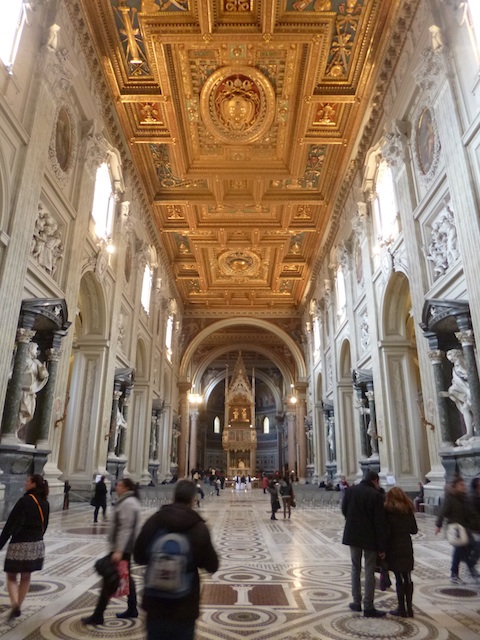San Giovanni in Laterano is Saint John Lateran, or the church of Saint John on Lateran Hill. I remember one parish priest admitting that, since St. John Lateran has a feast day he would pray to John Lateran on that day. Later he realized it was not a person but a building!
The original church was built in the 4th century when Emperor Constantine took the land of a disgraced family and gave it to Pope Melchiades. The church includes the Lateran Palace, which was the official residence of the pope until 1309. The basilica is still the pope's official cathedral as bishop of Rome, so it is Pope Francis's home parish. The church definitely follows a "Jesus and His Apostles" theme, as can be seen with the roof statues.
The front porch has some fantastic decoration, including a papal seal for a seemingly young and innocent pope. Also, one of the bronze doors is only opened for holy years (often those divisible by 25, though other special occasions sometimes arise).
The interior of the church was redone in 1646 by Boromini with ornate Counter-Reformation exuberance. The nave is lined with statues of the apostles. Jacob was excited to see Jacob Major (James the Greater) was one of the statues!
The main altar in the center of the church is the Papal Altar. Only the pope celebrates Mass here.
Behind the main altar, in the apse, is the Pope's chair or cathedra, from which "cathedral" is derived. It is his chair as bishop of Rome.
In addition to the Baby Jesus by the main altar, two side altars had Christmas nativities.
Many side chapels are dedicated to different popes, including this one for Leo XIII.
Even the floor impressed me with its fancy designs.
As we left, we saw the typical line of merchants who were sheltering from the on-again, off-again January rain. Luckily, they were off to the side and easy to avoid.
 |
| San Giovanni in Laterano |
The original church was built in the 4th century when Emperor Constantine took the land of a disgraced family and gave it to Pope Melchiades. The church includes the Lateran Palace, which was the official residence of the pope until 1309. The basilica is still the pope's official cathedral as bishop of Rome, so it is Pope Francis's home parish. The church definitely follows a "Jesus and His Apostles" theme, as can be seen with the roof statues.
 |
| Closer view of some of the roof statues--Jesus in the middle of course! |
The front porch has some fantastic decoration, including a papal seal for a seemingly young and innocent pope. Also, one of the bronze doors is only opened for holy years (often those divisible by 25, though other special occasions sometimes arise).
 |
| Pope Innocent the Small? |
 |
| More decorations |
 |
| An outside statue |
 |
| Holy year door |
The interior of the church was redone in 1646 by Boromini with ornate Counter-Reformation exuberance. The nave is lined with statues of the apostles. Jacob was excited to see Jacob Major (James the Greater) was one of the statues!
 |
| Nave |
 |
| Amazing ceiling (click to enlarge) |
 |
| Apostle John |
 |
| Jacob Major! |
 |
| Peter, who is at the front, naturally |
The main altar in the center of the church is the Papal Altar. Only the pope celebrates Mass here.
 |
| Main altar |
 |
| Baby Jesus |
Behind the main altar, in the apse, is the Pope's chair or cathedra, from which "cathedral" is derived. It is his chair as bishop of Rome.
 |
| Apse and papal cathedra |
 |
| Mosaic detail |
In addition to the Baby Jesus by the main altar, two side altars had Christmas nativities.
 |
| Side altar as you enter the cathedral |
 |
| Simple nativity |
 |
| More elaborate nativity further up |
Many side chapels are dedicated to different popes, including this one for Leo XIII.
 |
| Leo XIII memorial |
 |
| Side altar |
 |
| Dome to the side altar |
 |
| Side altar with fresco |
Even the floor impressed me with its fancy designs.
 |
| Floor design |
 |
| Holy Spirit on the floor! |
As we left, we saw the typical line of merchants who were sheltering from the on-again, off-again January rain. Luckily, they were off to the side and easy to avoid.
 |
| The shopping gauntlet |



No comments:
Post a Comment